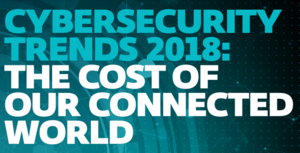
ESET security experts present the areas that they expect to be leading security priorities for the upcoming year, and suggest ways to mitigate the possible risk that they pose.
2017 was a big year for cybersecurity incidents, with attacks like WannaCry, DiskCoder.C and Equifax, to name a few.
Not only did these high profile cases impact millions of users worldwide, they also caused a significant financial blow to multinational companies and government agencies.
This brings us onto our Cybersecurity Trends 2018: The Cost of our Connected World report.
We can never predict what issues may occur throughout 2018, or whether the issues covered will come to pass, but we hope our report can enlighten readers and help raise awareness of the problems that may occur.
Ransomware
Ransomware is malicious software which will lock a system or encrypt files, converting files into an unreadable format and then demand a payment in order to ‘unlock’ these files. The WannaCry outbreak which struck the NHS last year is an example of how crippling a ransomware cryptoworm epidemic can be.
To keep your data safe, David Harley, ESET Senior Research Fellow, advises “back up everything that matters to you, often, by keeping at least some backups offline in a physically secure location.”
Critical infrastructure attacks
In the UK, there are 13 national infrastructure sectors, but not everything within a national infrastructure sector is judged ‘critical’. They are only critical if the loss or compromise would result in major detrimental impact on the availability, delivery or integrity of essential services.
Threats to critical infrastructure are expected to continue to generate headlines in 2018, and Stephen Cobb, ESET Senior Security Researcher, suggests it isn’t just government infrastructure we need to be concerned about. “Attackers may find it hard to hack into the network of a large utility company directly, but what if they hack the company that supplies janitorial services instead?”
Doing time for cybercrime: Police and malware research
Spending time and energy making the life of cybercriminals harder is worth it. We believe it’s one of the best ways to help prevent cybercrime activity and to make the internet a safer place.
Situational crime prevention can be applied to combat cybercrime, and maps out techniques which can be grouped into various broad categories, a few of which relate to what ESET does.
Using these techniques we can be more effective at catching cybercriminals as ESET Senior Security Researcher,Alexis Dorais-Joncas , suggests “In order to perform the perfect cybercrime, each and every step must be executed perfectly, all the time. Cybercriminals are humans and humans make mistakes.”
Electoral processes: can they be hacked?
Recent elections have raised the question whether a cyberattack could influence an electoral process, and there is substantial evidence that electronic voting is far from secure.
Camilo Guttierrez, Head of Awareness and Research ESET Latin America, says, “There is no doubt that new risks come with every new advancement, but if we want to use technology to improve our lives, then we must prevent it from creating greater problems overall than benefits.”
Personal data in the new age of technology and legislation
Tony Anscombe, ESET Global Security Evangelist and Industry Partnership Ambassador, raises the question is the Internet of Things taking us into a public world in terms of personal data?
“Every time a device asks to be connected we need to educate the end user to read the privacy policy and to make informed decisions about the data collection terms as set out in the privacy policy.”
We hope that the Trends 2018 report will help shed some light, for readers, on the key problems that have to be addressed in order to make progress toward a safer future.
What do you think of our proposed trends for 2018? Let us know on Twitter @ESETUK.